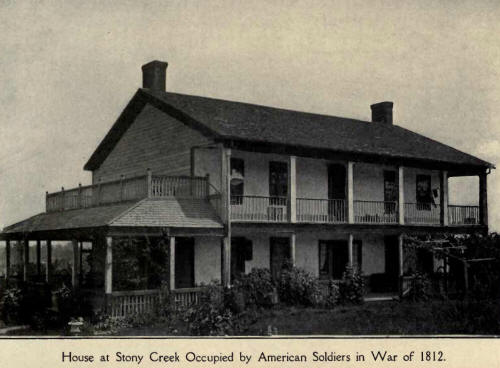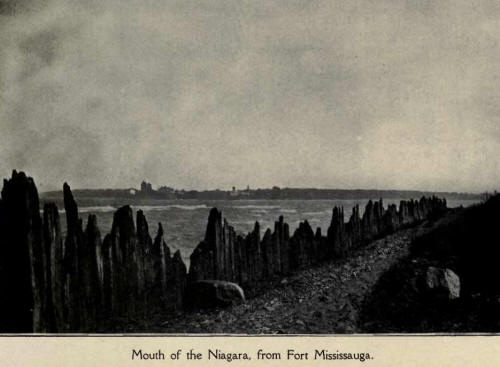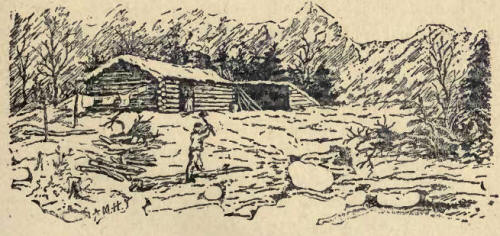|
THE WILD FRUITS—THE FAMILIAR WILD FLOWERS—LOST
IN THE WOODS—FOREST FIRES—A PRIMITIVE
CANADIAN BAND - MOSQUITOES AND BLACK FLIES.
THE woods were full of wild fruits and
berries, many specimens of which have
disappeared since the country became cleared.
These fruits, such as wild plums, grapes,
cherries and crab apples, were plentifully made use of by the settlers
before the latter were able to raise cultivated
fruits of their own. Some of our best varieties
of domestic fruit were propagated from these
wild fruit stocks. The best results are still
got by grafting on wild stocks. Among the berries
were the strawberry, blackberry, raspberry, huckleberry
(blueberry), cranberry, gooseberry, red and black
currants. Some of these berries were to be found in
profusion in the woods, in the slashings and around
the stumps and fences of the clearings. Berry picking
was one of the necessary occupations of the women and
children of the family in the summer time. The berries
were dried and made into sauce and preserves
for winter use. Frequently, in pioneer times, the berry
pickers would come upon bruin helping himself to his share of the crop of
berries. Many of us later-day folks have some pleasant recollection of
berry picking in our younger days. After a long tramp, we would sometimes
return home famished for want of water, tired and hungry, and many times
with empty pails, what few berries we did get being eaten to help satisfy
the cravings of our empty stomachs.
The Familiar Wild Flowers.
So few people are familiar with the appearance of the
common wild flowers, let alone their names, that it will be a surprise to
many of them to be told that there are hundreds of varieties in Canada. We
may take notice of flowers, perhaps, when we see them in gardens or
hot-houses, but very few of us realize that the most beautiful of the
flowers in nearly every case, unless it is a tropical one, has its
original in the wild flowers of the woods. It is true cultivation and
fertilization have made a great change in their appearance, both as to
size and beauty, but a true student of nature can see plenty to interest
him in the modest flowers along the road, on the hillsides and in the
woods of our glorious Canadian land. To find the different kinds one must
go to the localities where certain varieties are known to grow. In the
early days, when the country was covered with forest, he would not have
far to travel, but nowadays he might have to trudge many a weary mile to
secure a particular variety, for although it may not have become extinct
altogether, it is now more difficult to find. But why should we not know
something about our wild flowers of the forest? When once we have learned
to recognize a flower and know its name, we can never forget it. It is not
necessary for us to pull it to pieces to find out what flower it is—we
leave that to the botanist—for when once known there is always some
prominent distinguishing mark by which it is easily known. Flowers bloom
in Canada from the time the snow leaves the ground in the spring till it
comes again, but the month of June is the month of flowers, and it is in
that month they are to be seen in their greatest variety and perfection.
We will enumerate some of the more common occurring ones. Before the snow
has entirely left the ground in the spring, in the open woods are to be
found the hepaticas, pretty little flowers; then come the trilliums,
purple and white, which look like silent sentinels in the not too densely
shaded woods. The pretty columbine, with its scarlet hooded flowers and
desiccated leaves, is to be seen here and there in some shady recess. The
different varieties of ferns, stalwart cryptogams, the most prominent of
which is the cinnamon or flowering fern, fill up the vacant spaces of the
moist ground. On the hillsides and open grassy plains grow the violets,
modest little flowers half hidden by the grass; the ox-eye daisy, which in
June and July dots the meadows like the stars in the sky; the wavy lupine,
with its wealth of blue ; the wild rose, with its delightful perfume,
around whose stalk the bindweed climbs for support, mingling its white
flowers with the delicate hue of the roses, and, last of all, the
buttercup, which on account of its commonness is scarcely noticed.
Lost in the Woods.
Those of us living at the present day can scarcely
realize what, it meant to be lost in the woods in the early days, when the
country was covered with primeval forest and in which abounded ferocious
wild animals. We can imagine we see the look of anxiety on some fond
mother's face, when she found out that one of her children was
missing—lost in the woods! This was a terrible time of trial and anxiety,
only relieved by the joy of having been found.
It was an easy matter for even grown persons to lose
their bearings in the big stretches of bush, for in many cases the
settlers lived three and four miles apart. Oftentimes children would get
lost when sent after the cows, which were allowed to roam through the
woods in search of pasture. Or, perhaps, when picking berries or looking
for wild flowers, with which the woods were filled, children would lose
track of the familiar landmarks, and when they were ready to return home
would not know which direction to take. In one instance known to the
writer, a boy was lost for three or four days, and when found was so weak
from want of food that he could scarcely walk.
It was dangerous to get lost in the woods in the early
days, for besides the liability of starving to death, there was always the
danger of being attacked by the wild beasts with which the forest
abounded. Oftentimes men when travelling through the woods would be
overtaken by darkness, and not being able to find their way, would have to
remain out over night, perhaps perched in the branches of some tree, so as
to be out of reach of the wolves and bears, and then there was danger of
some treacherous wild-cat springing upon them. When it was reported that
any one had been lost, the whole township would turn out to help hunt for
the missing one, and would sometimes keep up the search for days. They
would divide off in searching parties and would shoot off guns, blow horns
and rattle tin pans to attract the attention of the missing party, as well
as to let each other know where they were. When the missing one was found,
a signal arranged beforehand, such as the shooting off of a gun three
times, was given to let the other parties know, so that they could give up
the search. Sometimes the searching party would form a line through the
woods, of, perhaps, a hundred or more persons, and reaching a couple of
miles or more, not so far apart but that each person could see the person
nearest to him. In that way they would march right through the settlement,
the end men having horns to notify the others.
The following story is told of several men who lost
their way in the woods of Upper Canada about fifty years ago. They were
out for a stroll one afternoon, and although only a short distance from
home were unable to find their way back. For two nights they were obliged
to sleep on a bed of spruce boughs, and to subsist on beech-tree leaves.
One of them being a smoker had a supply of matches in his pocket, so they
were able to make a fire at night to help keep them warm, and to drive
away the mosquitoes. The third day, after wandering around in a fruitless
endeavor to find the house, they heard a cow-bell, and knew they must be
near some human habitation, so when they reached the cow one of them
caught hold of its tail while the other thrashed it with a stick. The cow,
not liking-this treatment, struck out for home, just as they expected she
would do, taking the men with her and bringing them to a small clearing,
with a hut and a patch of potatoes. They here found that they had wandered
twenty miles from home.
NOTE.—It is said that people when travelling through
the Woods can tell the direction they are going by noticing the moss on
the trees, which always grows on the north side of a tree. Sugar makers
take advantage of this fact, and generally tap the maple tree on the south
or sunny side.
Forest Fires.

At times during seasons of drouth, in certain sections
of the country, fires would sweep through the woods and burn up large
stretches of valuable timber land. These fires often originated in the
choppings of the newly settled districts, when the settler was burning up
his brush or log heaps, and sometimes from the Indian camp-fires. Being
fed by the decaying logs and fallen timber in the surrounding bush, and
fanned by the wind created by the intense heat, the flames would spread
with great rapidity, killing and destroying the standing as well as
burning up the fallen trees. For some time after a forest fire the country
would look quite desolate until new growths of trees had taken the place
of those which had been destroyed. The smoke created by these fires would
darken the air for miles around and often necessitated lighting the
candles early in the afternoon. The frightened deer and other wild animals
could be seen running pell-mell to escape the conflagration. The settlers
would often have to get out and fight the fire for days to prevent it from
getting to their farm buildings; and oftentimes in spite of their efforts
their barns and dwelling houses would be destroyed. One method of
arresting the progress of the fire was by ploughing a number of furrows so
as to prevent its creeping along the dry grass, but oftentimes the flames
would leap over these barriers, as well as over streams of water and catch
at the opposite side. When the fire got in the vicinity of their buildings
the settlers would cover the roof and sides of the houses with blankets
wet with water to prevent them from taking fire.
A Primitive Canadian Band.
One of the few things that helped to enliven the summer
evenings in the backwoods settlements was the "Bull Frog Chorus." As soon
as the frost had disappeared from the ground in the spring their nightly
din could be heard and all were glad to hear it, for it was the welcome
harbinger of warm weather. If the settler happened to wake up in the night
he would hear through the open window the continuous racket made by these
dwellers in the pools and ponds, accompanied by the chirp of the
tree-toad, the hoot of the night owl, and the song of the katydid or
whip-poor-will. This swamp music was loudest in the spring, but died out
somewhat late in 'the summer and fall, when the low places became dry. If
surrounded by cheerful company the croaking of the frogs was not
unpleasant, but if feeling sad or lonely, or if goixg through some wild
swampy place alone at night it made everything appear dismal and forsaken.
City people are sometimes glad to get away for a season to the backwoods,
where they can quietly listen to the monotonous music of the frogs. The
never-ceasing chr-r-r-r made by the millions of small frogs, lizards, or
tree-toads, interspersed with such sounds as—croak, croak—cloog, cloog—chuck,
chuckbur-r-r, in various degrees of pitch, from the loud bass to the high
alto and tenor, all giving a feeling of dreamy listlessness to the place
that is a change from the noisy life of the city. When passing by a swamp
at night, it would seem as if the whole place were alive, but on going
close to the water the near-by noise ceases and save an occasional splash,
as some big frog plunges into the water to get out of the way, all is
quiet, with no sign of life, excepting perhaps here and there some
solitary frog sitting on a root sticking up out of the water. Various
amusing interpretations have been given to the noises of the frogs. They
are generally of a local character and a take-off on some well-known
individual in the place. We give the following story, related to the
writer by a gentleman well acquainted with the men referred to, as an
illustration. On the shores of Lake Scugog is a large marsh, near which is
situated the village of Port Perry. Some years ago three of the prominent
men of the place were Mr. Thomas Paxton, formerly member for North
Ontario, and afterwards sheriff of the County, who carried on a large
sawmill business there; Mr. W. S. Sexton, once warden of the county, who
was also engaged in the sawmill business on an extensive scale, and was a
well-known man in the neighborhood, and Mr. Joseph Bigelow, who owned a
store in the village and did a large business. The inhabitants of the
village who listened to the nightly music in the marsh gave the refrain of
the frogs the following interpretation
"Old.Sax-ton!
Tom-Paxton!
Bigelow-too!
Bigelow-too
Mosquitoes and Black Flies.

Two of the pests of the backwoodsman's life were the
mosquitoes and black flies. They did not, like the wolves and bears,
devour their victims, but they made life for man and beast during certain
seasons of the year almost unbearable. The black fly time came in May and
June. Their home was in the dense damp woods, but they were brought by the
cattle out to the clearings. They were a terrible torment, for, unlike the
mosquitoes, they could not be kept away from the face by netting, they
managed so to work their way in under the clothing. Their bite was very
painful and poisonous, and caused the flesh to swell badly. The settlers
sometimes smeared their faces with grease in order to pre vent the flies
from biting. As the clearings became larger these pests happily
disappeared. The monotonous droning of the mosquito could be heard any
night in the summer, a cessation of his song being usually followed by his
alighting on some unprotected part of the body, and his presence being
made known immediately after by an itching, sore feeling which followed
the insertion of his proboscis underneath the skin. If there were an
opening of any kind in the drapery of the bed, or in the netting of the
bedroom window, Mr. and Mrs. Mosquito, and their uncles and aunts were
sure to find their way in. They were as a rule worse before a rainstorm.
The backwoods folks would make a smudge of chips to keep them out, but
this itself was a torture, for the smoke was suffocating as well as
irritating to the eyes. The settlers would often make a smudge for the
cattle out of damp wood, as the cattle would frequently come home frantic
from the bites of these pests. Deer have been known to get in among the
cattle to get the benefit of the smudge. It is claimed by medical men now
that in malarial regions malarial disorders are contracted through the
bite of the mosquito. After the country became cleared, so that the sun
and wind could get in to dry up the moist low ground, their breeding
places, this diminutive elephant became scarcer and was not seen,
excepting in damp weather, or around the family rain barrel. The sand
fly—bite-em-no-see-em, as the Indians call it—was also a great annoyance
to the settlers. It also was worst in damp weather.

|

